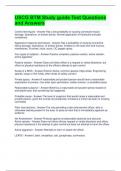USCG BTM Study guide Test Questions
and Answers
Control techniques - Answer-Has a low probability of causing connective tissue
damage, lacerations, or broken bones. Normal application of handcuffs and pain
compliance.
Aggressive response techniques - Answer-Has a probability of causing connective
tissue damage, lacerations, or broken bones. Irritation to the eyes skin and mucous
membranes. Punches, kicks, stuns, OC pepper spray.
Four types of subjects - Answer-Passive compliant, passive resistor, active resistor,
active aggressor
Passive resistor - Answer-Does not follow officer is a request or verbal directions, but
offers no physical resistance to the officers attempt to gain control
Scope of a BISS - Answer-Exterior decks, common spaces, bilge areas, Engineering
spaces, cargo or fish holds, other areas of safety concern
Private space - Answer-A reasonable and prudent person would have a reasonable
expectation of privacy. Can enter upon permission, safety concern, or probable cause
Reasonable suspicion - Answer-Belief by a reasonable and prudent person based on
articulable facts, that something has happened
Probable cause - Answer-The level of suspicion that would cause a reasonable and
prudent person, given the overall circumstances, to believe a crime has been or is being
committed
Plain view doctrine - Answer-The rule permitting a law enforcement officer, who is
otherwise lawfully present in the area, to seize an item that is immediately apparent as
evidence
4th Amendment - Answer-Protects against unreasonable searches and seizures
Active resistor - Answer-Does not follow officres request or verbal directions and offers
physical resistance 2 the attempt to gain control but does not attempt to harm the officer
Active aggressor - Answer-Attempts to harm or attack the officer
LEAPS - Answer-Listen, empathize, ask, paraphrase, summarize
, When is it appropriate to draw your weapon? - Answer-1. when deadly force is
authorized. 2. When there is a reasonable possibility that the use of deadly force may
be required
Pressure point techniques - Answer-Infra-orbital, hypoglossal, mandibular angle, c-
clamp, jugular notch
Passive compliant subject - Answer-Follows officers requests or verbal direction
Authority - Answer-The government's legal power to act
Jurisdiction - Answer-The government's legal right to exercise authority over it's people,
vessels, and places
Jurisdiction triangle - Answer-Location, vessel/ flag, substantive law
Substantive law - Answer-One that prohibits certain action or requires affirmative
conduct
Types of vessels - Answer-Recreational/private, commercial, noncommercial/
government owned, warship
14 USC 89 - Answer-The Coast Guard shall enforce or assist in the enforcement of all
applicable federal laws on, under, and over the high seas and waters subject to the
jurisdiction of the United States.
SEAS II - Answer-Search, examine, arrest, seize, inquire, inspect
Use of force policy - Answer-Only that amount of force reasonably necessary under the
circumstances may be used. Excessive force may never be used.
Types of self defense - Answer-Individual, unit, national
Use of force continuum - Answer-Officer presence, verbal commands, control
techniques, aggressive response techniques, intermediate weapons, deadly force
Officer presence - Answer-Good uniform, blue light, boat, gun belt, attitude
Verbal commands - Answer-Task direction, command/ consequence
Intermediate weapons - Answer-Have a high probability of causing connective tissue
damage, lacerations, or broken bones. Expandable baton, less than lethal rounds
Deadly force - Answer-Force that is likely to cause death or serious physical injury.
Disfigurement broken bones unconsciousness.




